The 1941 February 15th Windstorm in the Iberian PeninsulaNATURAL HAZARDS
Robert Muir-Wood. Chief Research Officer
RMS Risk Management Solutions (London – United Kingdom)
It was 70 years ago, on the afternoon of February 15th 1941 that a windstorm burst on Portugal with unprecedented ferocity. The storm caused significant damage and disruption, making a direct hit on Lisbon while damaging winds affected the whole of Portugal. It remains one of the top five most severe windstorms across Europe during the 20th Century.

Commerce Square, Lisbon
Diario de Noticias’ covers
Introduction
The meteorological “set-up” that created the 1941 windstorm was characterized by the presence of a major Atlantic low with a strong jet stream situated along its southern flanks which triggered the formation of a rapidly-intensifying daughter storm propelled to the east by the jet. This is a situation found two or three times in a typical winter. However on most occasions, the large deep low is located over Iceland and intense daughter storms form and dissipate over the Northeast Atlantic.
What happens when the major ‘Icelandic’ low pressure system is located far to the south of its usual location? Such a situation occurred on St. Valentine’s Day, Friday February 14th 1941.
What happens when the major ‘Icelandic’ low pressure system is located far to the south?
The 1941 Storm ‘Set-Up’
- On February 13th 1941, a massive low pressure circulation was situated a thousand kilometers to the south of Iceland, covering much of the eastern north Atlantic. Its southern flank extended to the Azores and to the northeast trailed back to southern Greenland (map 1).
- By February 14th the centre of this large low pressure system had drifted to lie 200 kilometers to the southeast of Ireland. The southwestern side of the storm had straightened running northeast from the Azores to the southern tip of Greenland, causing Arctic air to mix with air from the tropics.
- Out to the west a new vortex had developed along this flank. By the morning of Saturday 15th this vortex depression was located 250 kilometers to the east of the Azores, travelling at 90 kilometers per hour (kph) towards the east and intensifying. Once the storm had reached the central Portugal coast (map 2), the central pressure had drop-ped close to 950 hPa1, the forward speed had begun to slow and the path started to curve towards the northeast.
- Two warm fronts fed by the tropic air mass were ahead of the storm, crossing Córdoba (Andalusia-Spain) around 1 pm with surface temperatures of 15-16ºC.
- The wind continued to build and the highest gusts were experienced in the cold front at around 4 pm on the afternoon of Saturday 15th February 1941. The high winds were over by 5 pm.
How strong were the winds?
There are a number of windspeed measurements reported from the storm, but these readings should be treated with some caution. Windspeed recorders were not necessarily calibrated, situated at standard elevations or sited to avoid obstruction from surrounding trees, buildings or topography -as they would be today. Also it is not clear which observations were actually recordedrather than simply being observed on a flickering anemometer.
However at a number of coastal locations, windspeeds were reported as ‘200 kph’ (Sintra, Ericeira and Montalegre in Portugal and Santander in Spain). Given the absence of any more exact measurements above 150 kph in Portugal, we can see there is some likely exaggeration in these figures. However despite the scarcity of windspeed recordings some indication about the extent and magnitude of the windfield can be reconstructed from the pattern of damage. The locations of highest damage and hence highest windspeeds in the storm are found between Lisbon and Porto (see map 2).
| Speed | ||
|---|---|---|
| kph | mph | |
| Locations in Portugal | ||
| Lisbon | 127 | 79 |
| Praia da Rocha (Algarve) | 130 | 81 |
| Portimão (Algarve) | 150 | 93 |
| Santiago do Cacem (sur de Lisboa) | 119 | 74 |
| Penhas Douradas (Serra Estrela) | 148 | 92 |
| Coimbra | 133 | 81 |
| Guarda | 126 | 78 |
| Oporto | 130 | 81 |
| Location in Spain | ||
| San Sebastián | 180 | 112 |
Damage to buildings
In Portugal the greatest damage to buildings was to factories, warehouses, barracks and airport hangers. Many military facilities were badly damaged, as well as large structures such as theaters, hospitals and schools. For ordinary houses and apartment buildings the greatest damage was to tiles and chimneys.
Damage to trees and the roofs of buildings also extended into northern Spain with reports concentrated in two areas: one inland affecting towns and villages around Logroño and the second in villages closer to the coast around Bilbao and locations to both east and west along the northern coast. While much of the interior region of northwest Spain was of low population, the absence of reports of damage from cities such as Valladolid and Salamanca suggests that windspeeds were lower over the region inland from the frontier with Portugal.
The patchy nature of the distribution of the most intense windspeeds is typical of other recent intense windstorms in Europe.
Damage to infrastructure and communications
There was major disruption of telephone lines and electricity as well as road and rail systems, so that on Sunday 16th it was reported that all communication had been lost between Lisbon and the rest of the country. More than 100 km of telegraph lines were destroyed.
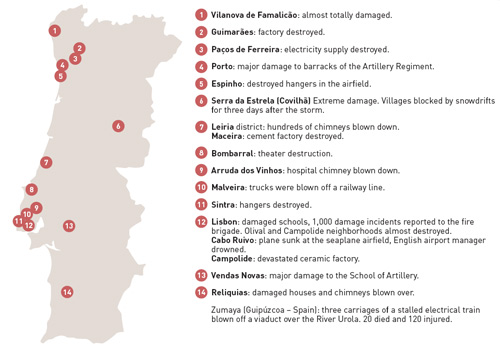
Property damage
Elaborated by the author from local press data
[+] zoom
Forestry damages
Enormous numbers of trees were blown over –or broken off– by the storm. There was no national survey of treefall in Portugal after the storm but on February 20th the Portuguese Diario Noticias announced as its main headline that ‘Incalculable damage had been caused to the nation’s arboreal resources’. Across Portugal as a whole one can estimate the total treefall was in the tens of millions of trees - perhaps 2-3% of the total at that time (as was the case in Lothar and Martin windstorms in France in 1999).
Along the Algarve in southern Portugal, there was widespread tree damage, in particular in town parks and farms. The destruction of olive and fruit trees also extended into southwest Spain (Cádiz, Sevilla, Córdoba y Jaén). These observations are consistent with the windspeed recordings along the Algarve, probably generally in the 130 kph range although locally and close to the coast rising to more than 150 kph (42 m/s).
In the most damaged locations up to 20% of mature trees were broken at the trunk or blown over. Based on experience from the highest windspeed areas of windstorm Lothar or the 1987J storm in southeast England, 25% attrition rates in mature forests suggest windspeeds of 45-48 m/s (150-170 kph).
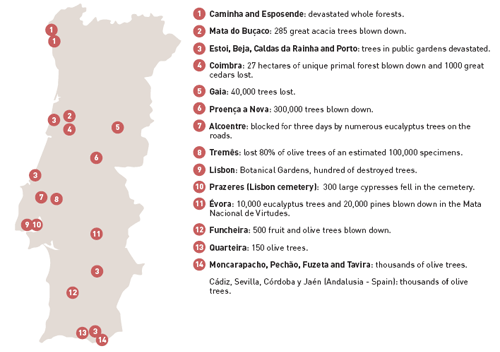
Forestry damage.
Elaborated by the author from local press data
[+] zoom
The patchy nature of the distribution of most intense windspeeds is typical of other recent intense windstorms in Europe
The storm along the coast and storm surge
A major storm surge was driven up the Tagus estuary, combining with strong wave action driven by the southwesterly winds to cause flooding on the northern coast of the estuary. In Lisbon, at the mouth of the estuary, it was reported that water levels in the port were one meter higher than usual. Large numbers of boats were damaged or sunk - including 150 boats sunk in the estuary close to Lisbon. Many manufacturers of salt had their facilities destroyed along the Tagus River.
To the east of Lisbon at Cascais, waves and water were thrown into the lower part of the town and a sea wall protecting the Casino was destroyed. At Estoril, sea water inundated the magnificent 200 year old cedars, between the Hotel do Parque and the Hotel Estoril.
Storm surge flooding was also intense at Sesimbra on the coast to the south of Lisbon, where the sea entered the lower part of the town, badly damaging and destroying houses and more than 300 boats were sunk or lost.
Further to the northwest, the Tagus estuary water levels were even higher: at the town of Alhandra houses were flooded with more than one meter of water. Waves destroyed the first line of houses and the debris was then carried into houses further back from the edge of the estuary. It was said that people died either because they hesitated before abandoning their homes, or chose to get through the swirling water at the wrong time. Although more than 100 people escaped from Alhandra at the height of the storm, 25 inhabitants were drowned. The death toll was feared to be much higher – potentially over 100, but many sailors had taken refuge on an offshore sand bank located parallel to the coast. In some places, this sand bank was eroded allowing waves to advance into the town of Vila Franca de Xira.
Along the Atlantic coast to the north of Lisbon, the coastline is generally steeper and while there were fewer reports of flooding, the waves were enormous and at a number of ports caused damaged.
Salt water from breaking waves offshore was carried by the winds and redeposited inland up to 40 kilometers from the coast, causing the vegetation to be scorched and damaged – as at Grandola. This is characteristic of extreme windspeed windstorms, as was experienced in the 1987J storm inland from the coasts of southeast England.
Fire following windstorm
In the City of Santander on the northern coast of Spain, in the centre of the path of highest winds, a fallen electrical power line created sparks that ignited a gasoline storage facility and moored tanker. Swept by the wind the fire burnt out of control consuming almost the whole of the town center over an area of 2 km2. This conflagration destroyed the 13th century cathedral and 300 major buildings including the Government revenue house and customs office, comprising 85% of the commercial center of the city. More than 30,000 people were forced to evacuate their homes.
Casualties
In a daytime storm casualties are typically five to six times higher than in a night-time storm because it is far more dangerous to be outside where there is potential to be struck by debris falling off roofs and chimneys as well as from falling branches and trees.
The windstorm occurred through the afternoon into the early evening on a Saturday, without proper warning and many people were outside in the storm. A total of at least 130 people are known to have died in the storm. These include:
- total of twenty were killed in Lisbon by falling trees, chimneys, tiles and other debris. Twenty-five at Alhandra and eight at Setúbal drowned in the storm surge.
- Nine people and two crew drowned in the sinking of a small ferry crossing the Tagus River inland at Tomar.
- Across the country of Portugal as a whole some thirty-two people were killed by falling chimneys with another fifteen killed by treefall.
- At Torres Novas three were killed in the collapse of a laundry.
- At least ten died of exposure having been caught outside walking between Portuguese villages in the mountains and then got trapped in the blizzard.
- And twenty were killed by a passenger train being blown off the viaduct in Guipúzcoa (Spain).
If the storm occurred today, many more people would have been killed while driving, but the number of incidents involving vehicles was only two -killing four people- reflecting low traffic levels. The population of Lisbon in 1941 was 650,000 while that of Portugal was 7.7 million. The per capita casualty rates in the path of the storm (adjusted for population) are higher than any other windstorm in Europe over the past 100 years.
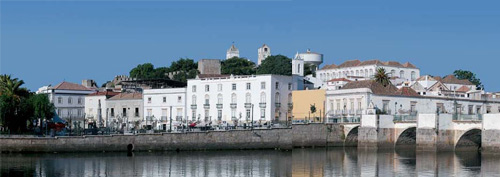
Tavira (Algarve)
The cost
Damages in Portugal from the windstorm were estimated to be ‘half the national budget’. The amount of damage in the storm was so significant that on February 20th the Ministry of Economics had to pass a prohibition against any price gouging – declaring that ‘prices of construction materials, including tiles, glass, windows and cement had to be brought back to those found before the storm’.
Estimates of damage in the storm were provided for a number of towns and provinces in Portugal and were reported in ‘contos’ (each equal to 1,000 escudos). Based on knowledge of the extent of the districts worst affected, which included Lisbon, Faro, Porto, Beja, Braga, Coimbra, Guarda, Viana do Castelo, Santarem, Leira, Aveiro and Viseu and the damage estimates for towns and villages which have survived, these suggest the total damage to the country was around 1,000,000 contos.
The total damage to Portugal was around 1,000,000 contos in 1941 or EUR 5 Billion in 2009
Some quoted estimations of financial damage in Portugal
following 1941 windstorm
Lisbon: in excess of 200,000 contos (450 chimneys knocked down and
widespread damage)
Towns along the Tagus estuary to the northeast of Lisbon was given as
25,000 contos (storm surge)
Island of Madeira: 80,000 contos
Algarve: 30,000 contos
Porto area: 25,000 contos
Porto de Mós: 3,500 contos just to the electrical supply system
Military aviation: 20,000 contos
(1 conto = 1,000 escudos)
How much would this be in today’s money?
In 1940 the official exchange rate was 27.5 escudos to the US dollar (USD), making one conto worth just under USD 40. One million contos would therefore be the equivalent of USD 40 million in 1941. However, USD 1 in 1940 is worth USD 15 today. At the same time, the Gross Domestic Product (GDP) of Portugal has increased by a factor of around 10 in the approximately 70 years between 1940 and 2009 and there has been a significant increase in the value of the property in the path of the storm. Therefore, one million contos in 1941 becomes the equivalent of around USD 6 Billion or around EUR 5 Billion in 2009.
Compared to Portugal, damage in Spain was generally more scattered and limited to rural areas – with the exception of the city of Santander, where we know the total damage to buildings and their contents was assessed at Pesetas 100-150 million, equal to USD 9 - 13.5 million in 1941 currency. Applying similar multiples to those employed for Portugal, the total equivalent damage in Spain (including the destruction of Santander) was around EUR 1-1.5 Billion in 2009.
In terms of damages, the 1941 Windstorm is the biggest catastrophe in the Iberian Peninsula in the last 200 years. It also caused more damage than any of the earthquakes in Portugal since 1755. In comparison with Windstorm Klaus on January 24th 2009, windspeeds along the northern coast of Spain were similar (130-150 kph) to those observed in 1941, but the 1941 storm caused comparable windspeeds over the interior of both Spain and Portugal as the track of the intense 1941 storm was located much closer to the Iberian coast. As today, Portuguese insurers do not explicitly purchase windstorm reinsurance for a repeat of a storm like that of 1941, nor do reinsurers specifically price this cover.
In terms of damages, the 1941 Windstorm is the biggest catastrophe in the Iberian Peninsula in the last 200 years
Bibliography
- http://www.rms.com
- Cereceda J.D. (1941) El ciclón del 15-16 de Febrero de 1941 sobre la península Ibérica, Estudios Geográficos 2 (2) pp131-141.
- Diario de Noticias (Lisboa), (1941) Ediciones del 16, 17, 18, 19, 20, 21, 22 y 23 de Febrero.
- Meteorological Office (1941) Air Ministry Meteorological Office, Daily Charts of Weather in the Northern Hemisphere.
- O Ciclone
http://guardadonaarca.no.sapo.pt/O%20ciclone.htm - Pio Pita D. (1941) El temporal de los días 15 y 16 de febrero de 1941, Aerotécnica, Revista de Aeronáutico, p169-175.
- “O Cezimbrense”, (1941) ‘O ciclone de 15 de Fevereiro de 1941’ (n.º 766, 23.3.1941)
http://expresso.sesimbra.pt/node/3775 - Severa tempestade de 15 Fevereiro 1941 em Portugal (2008)
http://www.meteopt.com/forum/eventos-meteorologicos/severa-tempestade-de-15-fevereiro-1941-em-portugal-793-2.html - Viñas Rubio J.M. (2001) Los temporales de viento en la Península Ibérica, Análisis meteorológico de la extraordinaria situación atmosférica de febrero de 1941, Gerencia de riesgos y seguros, Año XVIII Numero 74, 2nd Trimestre, 29-44.
1Hectopascal (hPa): a unit of measurement of atmospheric pressure equal to one milibar. That is 1000 dinas per square centimetre.
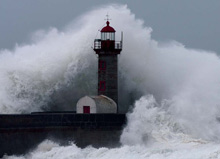
Lighthouse in Foz do Douro, Porto

Map 1: Situation on the surface prior to the 1941 February windstorm. Source: U.K. Met Office

Map 2: Situation on the surface on 15-02- 1941. Map by P. Mateo González (1955)

Lisbon Old quarter
 Porto
Porto 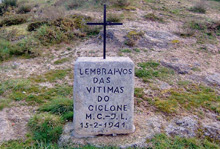 In remembrance of victims who died due to 1941 windstorm in Gralheira, Portugal
In remembrance of victims who died due to 1941 windstorm in Gralheira, Portugal
